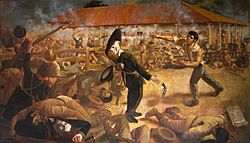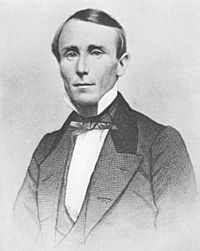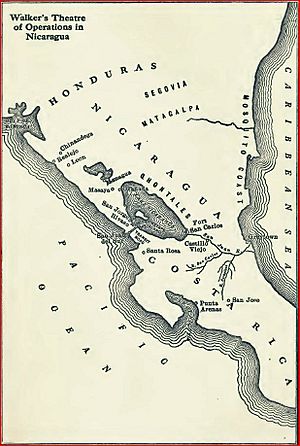Filibuster War facts for kids
Quick facts for kids William Walker's Invasion of Nicaragua |
|||||||
|---|---|---|---|---|---|---|---|
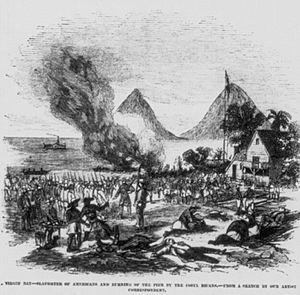 Costa Rican troops attacking William Walker at Rivas in 1856. |
|||||||
|
|||||||
| Belligerents | |||||||
|
Allied Central American Army (Ejército Aliado Centroamericano)
|
|||||||
| Commanders and leaders | |||||||
|
|
|||||||
| Strength | |||||||
| 5,213 mercenaries (1855–1857) | 2,500 men (Costa Rica) 4,000 men (Ejército Aliado Centroamericano) |
||||||
| Casualties and losses | |||||||
| 1,000 killed (all causes) |
1,202 killed 9,615 dead by cholera outbreak |
||||||
The Filibuster War was a big conflict in Nicaragua between 1855 and 1857. It involved an American adventurer named William Walker and his private army, called 'Filibusters.' They fought against a group of armies from several Central American countries. Walker took control of Nicaragua for a short time, but he was eventually defeated.
Contents
Why the War Started
Nicaragua became independent in 1838. But it still faced problems from other countries.
The Gold Rush and a Canal
In the 1850s, the California Gold Rush made the United States want a faster way to travel between its east and west coasts. Building a canal through Central America seemed like a good idea. However, Great Britain also had interests in Nicaragua, causing tension.
To avoid conflict, the Clayton–Bulwer Treaty was signed in 1850. Both the U.S. and Britain agreed not to control any future canal alone. Many Nicaraguans liked this treaty. They hoped a canal would bring money to their country.
Political Fights in Nicaragua
After gaining independence, Nicaragua had two main political groups. The 'Liberal party' was based in León. The 'Conservative party' was based in Granada. These two groups often fought for power.
William Walker's Arrival
In 1854, a civil war broke out in Nicaragua. The Liberal party was losing to the Conservative party. The Liberals asked for help from an American mercenary named William Walker. A mercenary is a soldier who fights for money. Walker was known for trying to take over Latin American countries. He wanted them to become part of the United States.
To get around U.S. laws, Walker signed a deal with the Liberal president, Francisco Castellón. This deal allowed him to bring "colonists" to Nicaragua. On May 3, 1855, Walker sailed from San Francisco with about 60 men. Once he landed, his group grew to include 170 local people and 100 Americans.
Walker Takes Control
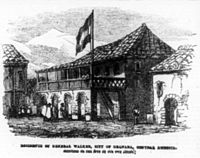
With President Castellón's permission, Walker attacked the Conservatives in Rivas. He was pushed back but caused many losses. On September 4, Walker won the Battle of La Virgen. On October 13, he captured Granada, the Conservative capital. This gave him control of the country.
At first, Walker ruled Nicaragua through a "puppet" president, Patricio Rivas. A puppet president is someone who seems to be in charge but is actually controlled by someone else. The U.S. President, Franklin Pierce, even recognized Walker's government as the real one in Nicaragua.
Later, Walker declared himself president. He brought back slavery and made English the official language.
Central American Countries Fight Back
Walker's talk of taking over more countries worried Nicaragua's neighbors. Juan Rafael Mora, the President of Costa Rica, refused to work with Walker. Instead, he declared war. Walker sent his troops to invade Costa Rica, but they were defeated in the Battle of Santa Rosa in March 1856.
In April 1856, Costa Rican troops entered Nicaragua. They defeated Walker's men at the Second Battle of Rivas. During this battle, Juan Santamaría, a Costa Rican hero, bravely burned down the building where the Filibusters were hiding.
Walker became president of Nicaragua after an election where he had no opponents. He started his rule on July 12, 1856. He continued his plan to make Nicaragua more like the U.S. He brought back slavery, made English the official language, and changed money rules.
Meanwhile, Honduras, El Salvador, and Guatemala signed a treaty on July 18, 1856. They agreed to defend their freedom. They also recognized Patricio Rivas as the true president of Nicaragua. Costa Rica couldn't join right away because many of its soldiers were sick with cholera. But they would join the fight later.
On September 12, the Liberal and Conservative groups in Nicaragua also joined forces. They declared war against William Walker. On September 14, the allied army, called the Septentrión Army, won their first victory for Nicaragua at the Battle of San Jacinto. By the end of 1856, Walker ordered the destruction of Granada.
Cutting Off Walker's Supplies
Costa Rica rejoined the fight in late 1856. They planned to take control of the San Juan River. This river was important because it was how Walker got weapons and new soldiers. A businessman named Cornelius Vanderbilt sent his agent, Sylvanus Spencer, to help Costa Rica. Vanderbilt wanted to get back his shipping company, which Walker had taken.
By January 1857, the Costa Rican army controlled the San Juan River. They also had all of Vanderbilt's ships. This cut off Walker's main supply route.
Walker was forced out of Granada by the allied armies. Some of his reinforcements tried to get the river back, but they failed. By April 1857, Walker had taken Rivas again. The allied armies then surrounded the city in what was called the Third Battle of Rivas.
Walker Gives Up
Costa Rica, Honduras, and other Central American countries worked together to force Walker out in 1857. During this time, Granada was burned. Thousands of Central Americans died. The last major battle of this "National War" happened in spring 1857 in Rivas. Walker fought hard, but his army became weak and tired.
The war also brought together the Liberal and Conservative parties in Nicaragua. These were the same parties that had first invited Walker to Nicaragua. On May 1, 1857, Walker surrendered to Commander Charles Henry Davis of the United States Navy. He was sent back to the U.S. When he arrived in New York City, people cheered him as a hero. But he upset many when he blamed his defeat on the U.S. Navy.
Important Dates
- 1855
- June 29: First Battle of Rivas. Nicaraguan troops win against Walker.
- August 30: Filibuster troops take the port of San Juan del Sur.
- September 3: Battle of La Virgen. Walker defeats his opponents.
- October 13: Filibusters capture the city of Granada.
- 1856
- March 20: Battle of Santa Rosa in Costa Rica.
- April 11: Second Battle of Rivas. Costa Rican troops stop Walker's attack. Juan Santamaría is a hero here.
- April 26: Costa Rican troops leave Nicaragua because many are sick with cholera.
- September 14: Nicaraguan patriots win against the filibusters at the Battle of San Jacinto.
- September 22: William Walker makes slavery legal in Nicaragua.
- November 7: Costa Rican troops take San Juan del Sur.
- November 11-13: First Battle of Masaya. The Allied Central American Army pushes back the filibusters.
- November 11: Battle of the Transit. William Walker's troops win.
- November 15-17: Second Battle of Masaya. Central American allies stop Walker's troops again.
- November 24 - December 14: Granada is destroyed.
- December 16: Walker takes the city of Rivas.
- December: Costa Rican troops start taking river ships and forts along the San Juan River.
- 1857
- January 3: Costa Rican troops take the ship "San Carlos." This cuts off Walker's access to the Atlantic Ocean.
- January 28: Allied troops take the lake port of San Jorge.
- March 5: Nicaraguan and Central American troops defeat the filibusters at the Battle of El Jocote.
- March 23: Third Battle of Rivas. Central American allies attack the town but don't win.
- April 11: Fourth Battle of Rivas. Central American allies attack the town again without success.
- April 17: Central American Allied troops take San Juan del Sur.
- May 1: William Walker surrenders to U.S. Captain Charles H. Davis.
- May 5: William Walker leaves Nicaragua on the ship St. Mary's.
Images for kids
-
President Walker's house in Granada, Nicaragua.
-
William Walker, the American who took over Nicaragua from 1855–1857.
See also
 In Spanish: Campaña Nacional de 1856-1857 para niños
In Spanish: Campaña Nacional de 1856-1857 para niños



